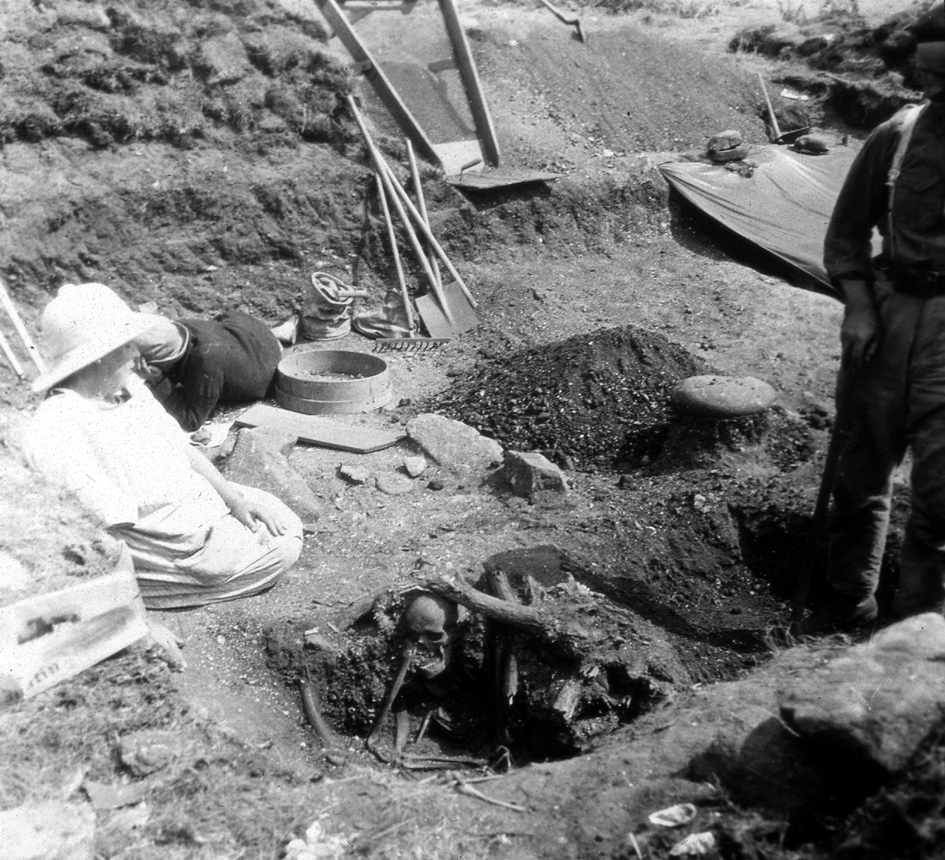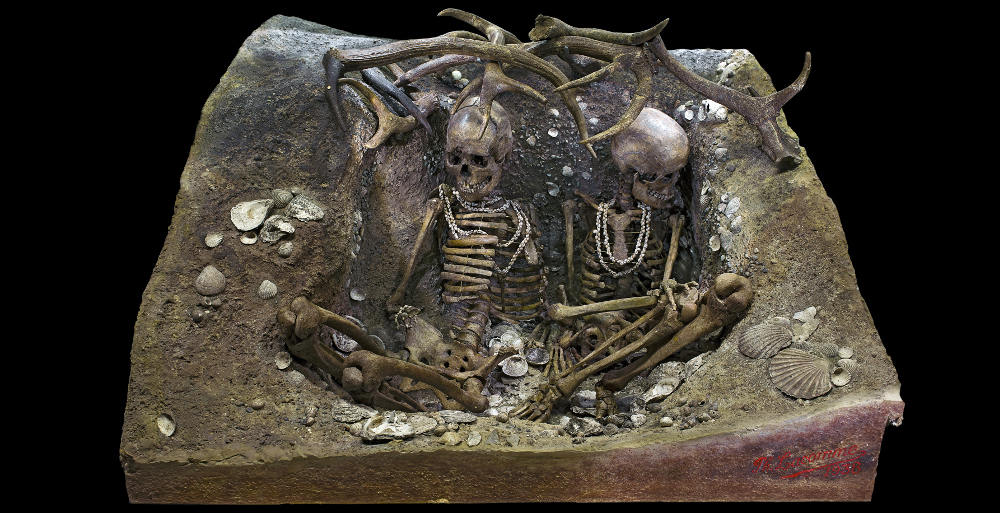The settlement of the last coastal hunter-farmers of Brittany
7400 years ago, Téviec was an oceanfront hill dominating coastal marshes. Due to the rise in sea level, it became a small deserted island in the Saint-Pierre-Quiberon commune in the Morbihan. The Mesolithic populations (9700-5300 B.C.) had established a vast settlement there at the foot of the granite headland. It is made up of a layer of food waste consisting primarily of seashells, 0.6- 1m wide, and a number of archaeological structures (different types of homes and tombs).

Archaeological digs, led by Marthe and Saint-Just Péquart took place there from 1928-1930 and covered a surface of 320m². From 2000 onwards, all the bodies exhumed and preserved there were subject to new scientific analysis. Above all, they revealed dietary habits heavily based on the intensive exploitation of sea animals (molluscs, crabs and fish) but also on large terrestrial mammals (stags, deer, wild boars). In comparison to other coastal sites from the Mesalithic period, Téviec bears evidence of bird hunting (21 species, including mallards, widgeons, puffins, guillemots and woodcocks). Only dogs were domesticated.
Despite the numerous signs of settlement and the number of archaeological discoveries, it was most likely a nomad population moving in a circuit which included islands such as Groix or Belle-Ile.
An exceptional prehistoric necropolis
The digs allowed the exhumation of 10 sepulchres (23 individuals) all of them gathered together in a limited area of approximately 50m², at the very heart of the food waste and households. The most complex tombs were collective sepulchres (successive inhumations) and multiple ones (simultaneous inhumations).
All the sepulchres show evidence of elaborate rituals. Bodies donned with necklaces and hairnets made of shells were coated in red ochre. They had been buried in a bent position in unfinished graves, their legs forcefully bent in two and their heads slightly lifted. Knives made of flint, hammers on pebbles and styluses made out of bone accompanied the majority of the deceased. In two cases, a creation made from antlers formed a kind of frame around the skull. One or two slabs had been placed on the tomb and served as a base for what was supposedly a ritual fireplace. The ensemble was covered in stones and served a visual purpose as well as protecting the bodies. It would occasionally escape from under the shell layer and onto the ground.
A society of equality…and of violence
Even though the shells seem a little different in the men and women’s set of jewels, the two sexes were shown the same consideration in the funeral domain at least. The grouping of bodies in kinds of vaults displays the strong ties between certain individuals, perhaps on a family basis. Three sepulchres containing adults buried with a child open up the theory of a sacrifice at the death of a parent.
At the bottom of the K tomb, a man came to a tragic end, as is shown by the two arrowheads embedded in his vertebrae. His jaw had incidentally been fractured a while before and had since healed. A recent anthropological analysis carried out on sepulchre A- conserved at Toulouse’s Museum of Natural History- also lead us to believe that the two females had been massacred with the aid of blunt objects since their skulls showed signs of many blows to the head.
There are multiple possible interpretations of these marks of violence, they could have taken place as Mesolithic groups competed against each other to gain access to the rich coastal resources or it could have been due to a tense atmosphere as agricultural populations arrived in the East.

The archaeologists
Marthe and Saint-Juste-Péquart were archaeologists originally from Lorraine, who worked in Brittany and then in the Pyrenees between 1915 and 1942. They are known in particular for their digs on the Breton islands in the 1920’s and 1930’s, in particular Téviec and then in Hoëdic. They developed a meticulous scientific approach, by taking care in particular to create doubles of photographs and films, of which many have been preserved. Saint-Just-Péquart’s involvement with the Milice during the Second World War and his subsequent execution during the Liberation have brought discredit upon work, whose worth is now re-evaluated by contemporary analytical methods.
The small island of Téviec, now private property is no longer open to research, but there is no doubt that it still holds great scientific potential to help us understand pre-Neolithic societies.



